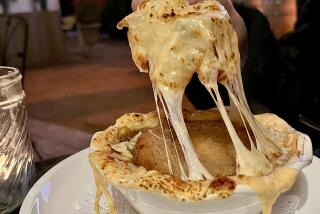When the Party Involves Guest Work
- Share via
“What can I bring?”
Doesn’t anybody recognize this question for what it is: rhetorical, purely polite and, most of all, an ardent plea to be released from all responsibility?
The ideal response is: “Just yourself.” (Of course, the party-giver knows that reply will bring a bottle of wine or box of hand-rolled truffles--a small something special just for the host or hostess.) Too often, however, I’ve heard the vague but binding words: “Oh, bring whatever you’d like.” And suddenly I’m committed not only to making and bringing something, but also to deciding what that something will be. I’d prefer a specific response, any specific response, except perhaps “Poached salmon for 60.”
So I’ve come up with my own answer: a French onion tart. Friends now request this pissaladiere for their cocktail parties. They demand it, in fact.
Provencal onion tarts had never really caught my attention until I came across Richard Olney’s book on the Provencal cook Lulu Peyraud (“Lulu’s Provencal Table,” HarperCollins). I knew just by reading the recipe that this pissaladiere was remarkable.
For one thing, the crust is criminally short--eight tablespoons of butter to one cup of flour. This is so short (as in shortening and shortbread) that sometimes I use only six tablespoons of butter to one cup of flour. Nobody has ever remarked on the difference. Once you eat this buttery pastry crust, pissaladieres made with the traditional yeasted bread crust will seem pale and dull.
The stellar component of this pissaladiere is the onions. I suggest splurging on Vidalia or even Maui onions--although the modest, standard yellow onion still produces glorious results. Some pissaladieres are made with caramelized onions, which are brown and mushy and, to my mind, inferior. Peyraud sweats her onions. She slices them very thin and puts them over low heat, stirring them occasionally with a wooden spoon. She cooks them until they have loosed impressive amounts of onion sweat, until this moisture has diminished and the contents resemble a puree. The onions remain a translucent pale blond and are unbelievably sweet. (These sweated onions are also excellent on pasta. Each time I make a pissaladiere, I seriously consider forgetting about the party to spend a quiet evening alone eating vast amounts of sweated onions on orecchiette.)
With the anchovies, extravagance pays off. I buy big cans of salt-packed Italian anchovies, which still have their skin and bones. The most laborious part of this tart is fileting and skinning the little fish, but the flavor is well worth the trouble--and can convert even intractable anchovy-loathers. Once I accidentally bought salt-packed sardines, which are larger, easier to handle and every bit as delicious. If fileting tiny fish is too much trouble, use any high-quality oil-packed anchovy or skinned, boneless salt-packed versions available at Italian grocers.
I also advise not stinting on the olives, but using small, authentic Nicoise olives. You need only a few tablespoons to dot the top. Other small, mild brine-cured olives can be used. Kalamata olives and salt-cured olives are too strong.
This tart is pretty, and it’s rustic. But best of all, it’s the solution to an age-old problem. Now when somebody tells you, “Bring anything,” you know exactly what to make.
(BEGIN TEXT OF INFOBOX / INFOGRAPHIC)
ONION TART, OR PISSALADIERE
Serves 6 to 8 as appetizer
Pastry:
1 cup flour
Salt
8 to 10 tablespoons cold butter, diced
About 4 tablespoons cold water
*
Filling:
4 tablespoons olive oil
2 pounds sweet onions, finely sliced
Salt
Sprig fresh thyme
Pepper
16 anchovy fillets
1/2 cup (2 ounces) Nicoise olives
*
Sift flour and salt into mixing bowl. Crumble flour mixture and butter together, rubbing lightly between thumb and fingertips. Don’t overwork pastry. Gather into ball with fork and some cold water, wrap in plastic and refrigerate for at least 1 hour.
Warm 2 tablespoons olive oil in heavy saute pan. Over low heat, add onions, salt and thyme and cook, covered, stirring occasionally, for 1 hour, or until onions are soft. Remove lid and cook until most liquid evaporates; onions should remain uncolored. Season with pepper.
Preheat oven to 375 degrees. With palm of hand, flatten pastry on generously floured work surface. Sprinkle with plenty of flour and roll out to 1/8-inch thickness. Roll up on rolling pin and unroll onto large baking sheet. Roll up and crimp edges with thumb dipped repeatedly in flour, or with fork tines.
Spread onions evenly over pastry. Arrange anchovy fillets into simple design--latticework or wheel spokes--and garnish with olives. Drizzle with remaining olive oil and bake about 30 minutes, or until pastry edges are golden and crisp. Serve hot or warm, cut into small squares for appetizer or large wedges for first course.
More to Read
Eat your way across L.A.
Get our weekly Tasting Notes newsletter for reviews, news and more.
You may occasionally receive promotional content from the Los Angeles Times.










